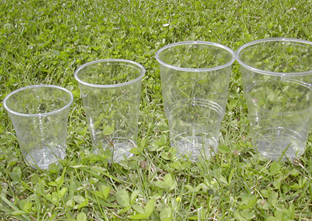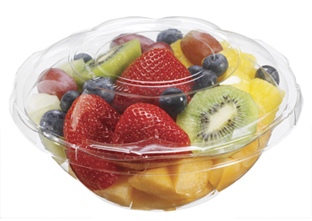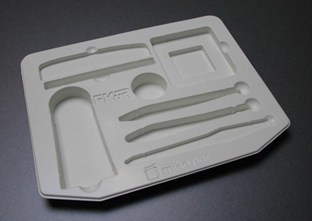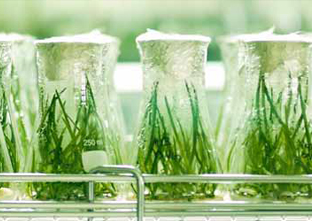"We have barely begun to explore the world of bioplastics!"

An internationally-reputed specialist in bio-polymers, he was ranked 18th in the world’s top 100 materials science researchers for 2010 (classification for the decade 2000-2010, published by Thomson Reuters).
You specialise in PLA, best known as a biodegradable plastic. Is this the main focus of research ?
Our laboratory has been working on turning bioresources – i.e., renewable organic carbon - to produce plastics, particularly derivatives of polylactic acid (PLA), for twenty-odd years now. Certainly, right at the start, but only then, we were looking to turn to these compounds not only for being biosourced but also for their biodegradability. By which I mean their capacity for disposal after use,and I am adamant about this, by natural means, i.e., once they have biodegraded after release into wastewater or by being composted. We are still working on that, but other avenues are now opening up to us.

Why has the focus slipped from biodegradability ?
 With hindsight, I think we overrated that property when the first bioplastics were launched fifteen-odd years ago. The appearance on the market of products like bin-bags whose polymers were not optimised overshadowed the other things that bioplastics could do. So much so, indeed, that the public tend to confuse them with biodegradable plastics. Obviously, it’s not a property to be dismissed, but the fact is that its applications are for products with low added value because, with disposables, we are talking about very time-limited use of between about a day and a month at the outside...whereas bioplastics are mostly for applications with a much longer lifetime.
With hindsight, I think we overrated that property when the first bioplastics were launched fifteen-odd years ago. The appearance on the market of products like bin-bags whose polymers were not optimised overshadowed the other things that bioplastics could do. So much so, indeed, that the public tend to confuse them with biodegradable plastics. Obviously, it’s not a property to be dismissed, but the fact is that its applications are for products with low added value because, with disposables, we are talking about very time-limited use of between about a day and a month at the outside...whereas bioplastics are mostly for applications with a much longer lifetime.
So PLA isn’t just for packaging ?
 It can do much, much more than that! But even in that field we haven’t yet sized up all its possibilities. In addition to just food packaging, we can now be looking at more sophisticated applications like protective plastics or foam cushioning, as well as making advances in other plastics-using sectors.
It can do much, much more than that! But even in that field we haven’t yet sized up all its possibilities. In addition to just food packaging, we can now be looking at more sophisticated applications like protective plastics or foam cushioning, as well as making advances in other plastics-using sectors.
Such as ... ?
I’m thinking, for example, of electronic equipment like cameras, mobile phones or computers...But also cars and public transport which have a clear need for sustainable applications and where plastics’ use is increasingly widespread to very good effect. These are areas where bioplastics can now deliver real benefits.
Generally, I think we now need to perform a handbrake turn and go for high value-added niche sectors where we can showcase the merits of bioplastics, then, once we have shown the benefits, move on to lower value-added applications.

Is industry on the same wavelength ?
 It’s forging ahead in some areas, although some manufacturers don’t really want to know due to unsuccessful first tests on the material some years ago. When they come out with this argument, I always point out they would have had the same concerns from testing polypropylene in the 1970s, twenty years after it was discovered...And I tell them that there are now different families of PLA with different grades and a wide range of physical and chemical properties. So, therefore, we shouldn’t be talking about PLA, but PLAs in the plural.
It’s forging ahead in some areas, although some manufacturers don’t really want to know due to unsuccessful first tests on the material some years ago. When they come out with this argument, I always point out they would have had the same concerns from testing polypropylene in the 1970s, twenty years after it was discovered...And I tell them that there are now different families of PLA with different grades and a wide range of physical and chemical properties. So, therefore, we shouldn’t be talking about PLA, but PLAs in the plural.
The problem is they want to get the advances with PLA and other bioplastics, that in some cases took half a century for conventional plastics, within a matter of years.
Any concrete solutions to offer to keep them happy in the meantime ?
 We’re researching into all levels of the value chain: from the production of intermediate chemicals upstream to plastics applications in the finished products of different sectors. In that way, we are trying to cover the entire bio-resource value chain.
We’re researching into all levels of the value chain: from the production of intermediate chemicals upstream to plastics applications in the finished products of different sectors. In that way, we are trying to cover the entire bio-resource value chain.
Materia Nova,our research centre, is working closely with business on processes for extracting and processing the basic components of these bioplastics, particularly PLA, through clean room technologies.
One key area of research is diversification of non-food bio-resources that can be used for this, in particular agricultural by-products. The University of Mons laboratory is looking at every way of converting the monomer into different polymers. It has recently broken new grounds with a purely organic, metal release-free polymerisation process for electronics and medical applications.
Then there is the PLA continuous catalytic process which recently went into the industrial stage in the Total Petrochemicals/Galactic partnership project FUTERRO.

And will we be seeing your research in the plastics we use ?
 Materia Nova has also gone a long way down the road of turning the different PLA-derived polymeric materials to make best use of certain properties like thermal behaviour, crystallinity and mechanical strength for specific applications, like developing flame-resistant plastic for transport and construction use.
Materia Nova has also gone a long way down the road of turning the different PLA-derived polymeric materials to make best use of certain properties like thermal behaviour, crystallinity and mechanical strength for specific applications, like developing flame-resistant plastic for transport and construction use.
Better yet, we can now produce 100% PLA composites with a range of functions by mixing the PLA substrate with PLA structuring nanofillers, the aim being to give the material moisture or carbon dioxide barrier properties.
MORE INFORMATION





